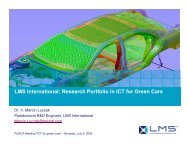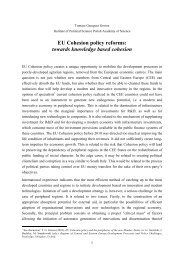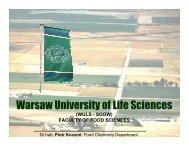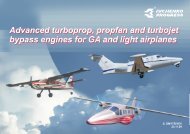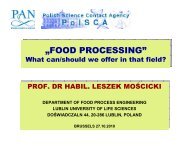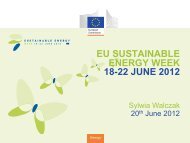You also want an ePaper? Increase the reach of your titles
YUMPU automatically turns print PDFs into web optimized ePapers that Google loves.
Energy consumption reduction<br />
in urban rail systems
Plan of the presentation<br />
Introducing the speaker and transport-related research at<br />
her university<br />
Urban rail transport in Poland - a very short overview<br />
Urban rail transport oriented research - centres, areas of<br />
interest, overview of projects<br />
Relevance of ongoing research to Sustainable Surface<br />
Transport Call within FP7 Transport Theme<br />
2
Speaker and her university<br />
<strong>Dr</strong>. <strong>Barbara</strong> <strong>Kulesz</strong>, currently employed at Silesian University of<br />
Technology, one of Polish technical universities. At present with the<br />
Department of Electrical Machines and Electrical Engineering in<br />
Transport, which is situated within Faculty of Electrical Engineering.<br />
3
Research scope and potential of my<br />
home unit<br />
In the past:<br />
• supply systems of railway traction (with stress laid on the issues of readjustment<br />
of peak loads at railway traction substations with the help of<br />
energy storage systems; a Ph.D. thesis may be mentioned here)<br />
• hybrid locomotives design (again, problems solved here related to<br />
determination of diesel shunting locomotives loads and possibilities of<br />
transforming them into hybrid, i.e. diesel-electric locomotives; a doctoral<br />
thesis must be recalled here)<br />
• rail vehicles drive systems (in particular, research has been aimed at<br />
design of new types of electric motors, such as induction motors and PM<br />
excited motors, which would be swapped for today’s standard dc<br />
motors)<br />
• rail vehicles static converters (used to drive fans cooling electric motors).<br />
4
My own field, for several years past, has been design and operation<br />
of multi-phase transformers for urban rail vehicles (mostly trams)<br />
traction substations. It covers issues such as quality of rectified<br />
voltage and impact of different types of transformer-rectifier sets on<br />
the supply grid.<br />
Nowadays our principal field of interest is associated with cars and<br />
includes:<br />
• car electronics (motor control systems – ignition, injection)<br />
• hybrid vehicles (cars and buses; algorithms for controlling<br />
diesel/electric drive – a very recent Ph.D. thesis)<br />
• electric energy storage systems (batteries and supercapacitors)<br />
used in conjunction with hybrid drive for car or bus<br />
• module hybrid drive system.<br />
5
Research example - Module hybrid drive<br />
system<br />
Module drive system is defined here as system which may be built into existing car IC motor<br />
without introducing any major constructional changes. This will operate in a manner similar to<br />
known hybrid drives. The proposed drive system will consist of electric machine acting as<br />
alternator, starter and auxiliary machine (this last function means generation of torque which<br />
adds to IC motor torque, e.g. during acceleration). During frequent stops the IC motor will be<br />
switched off, which will reduce both fuel consumption as well as noise and environmental<br />
pollution (CO 2 mostly). Electric motor supply will be run from super-capacitors via power<br />
electronics converter.<br />
Within the framework of the project we intend to:<br />
Design and build a small but high-power electric PM motor<br />
Design and build power electronics converter with control module<br />
Assembly mechanical transmission connecting electric machine to belt pulley<br />
of car engine shaft<br />
Put a super-capacitor battery into the system.<br />
6
Automatic switching off of IC motor, repeated switching on of drive motor (the IC motor<br />
start-up will be done with the help of electric motor operating as a starter)<br />
Recuperation of energy and charging batteries and super-capacitors. In this case<br />
electric machine will operate as alternator and be controlled in such a way as to provide<br />
fast supply of energy to charge the storage elements or to recover a part of braking<br />
energy. The electric machine will also operate as alternator in order to lower the load of<br />
IC engine (power to car lights, board appliances, IC engine ECU unit, ignition and<br />
injection systems, fuel pump will be taken from energy accumulators)<br />
Storage of energy in double accumulator (VRLA battery and super-capacitor bank).<br />
Super-capacitors will be used to provide starting energy to IC engine during repeated<br />
start-ups in urban communication.<br />
This system will be better than known existing hybrid drive systems or Stop and Go systems,<br />
since relatively cheap and mass-produced elements will be used. Its efficiency will be much<br />
higher than in case of known Stop and Go systems (electric PM motor with 94% efficiency as<br />
opposed to standard toothed rotor alternator with 50-60% efficiency); its power will be also<br />
several times higher.<br />
Thanks to this power it will be possible to fulfil three designed functions:<br />
Braking energy regeneration<br />
Start-up in electric mode<br />
Instantaneous assistance of IC engine.<br />
Together, these are seen as a novel solution of the old problem:<br />
decrease of fuel consumption and pollutants emission.<br />
7
Our research infrastructure<br />
In the field of electric traction:<br />
- electric motors, dc, ac, PM<br />
- power electronic converters<br />
- laboratory test stands with traction transformers-rectifier sets models<br />
In the field of hybrid/electric vehicle technology:<br />
- two electric vehicles (one fully registered and certified for road traffic),<br />
the third is currently being built<br />
- one of the above is also configured as hybrid car with series structure<br />
Measurement equipment:<br />
- Car diagnoscopes (Bosch, ADP), fully legalised<br />
- Multi-channel oscilloscopes Tektronix<br />
- Signal recorders (RCUF ) used in road measurements<br />
- Exhaust gas analyser MAHA<br />
- IC engine with control module (laboratory stand)<br />
- Thermovision equipment (FLIR camera)<br />
8
Urban rail transport in Poland<br />
Trams – 14 cities, Metro – 1 city, Trolleybuses – 3 cities<br />
Rolling stock manufacturers (home and abroad): Alstom Chorzów,FPS Poznań,<br />
Pesa Bydgoszcz, Bombardier, Siemens, Skoda<br />
Rolling stock modernisation: Modetrans Poznań, Protram Wrocław<br />
Together: 80 different types of tram cars<br />
As of 2009: 3669 trams, 85% of them with series-shunt dc drive<br />
Average energy consumption for standard(“classical”drive) - >=2.1kWh/km/one<br />
105Na car<br />
For asynchronous drive – 1.7kWh/km<br />
Energy save – c.19% (resistor losses during start-up are eliminated, asynchronous<br />
motor with higher efficiency – c. 5%, limiting resistor losses during braking,<br />
exchange of rotating voltage converter with static one).<br />
Additionally – fewer contact-type equipment, lower maintenance costs, lower failure<br />
frequency<br />
9
Example of urban transport network –<br />
GOP (Upper Silesia industrial region)<br />
Buses (one principal operator, several small operators)<br />
Private transport (minibuses)<br />
Rail transport: Trams, railway, trolleybuses<br />
300 bus lines, 29 tram lines, 1.2 mln persons/day<br />
Rail transport:<br />
Tram lines 210 km and 338 stops, 12 cities<br />
Railways 180 km, 55 stations, different lines<br />
Integration: buses and trams only<br />
Rolling stock: 5% of tram cars < 5 years<br />
57% of tram cars – between 20 and 30 years<br />
Modern trams (with energy recuperation, low floors) – 24 trams out of 346 (2009)<br />
Trolleybuses (one town) – 6 cars with energy recuperation (out of 21),<br />
1.2 mln km per year<br />
10
Transport policy for cities and<br />
agglomerations for 2007-2013<br />
• Strategy of State Development 2007-2015<br />
• National Strategy Framework 2007-2013 (Coherence<br />
National Strategy)<br />
• Operational Programme “Infrastructure and<br />
Environment” – 37.6B euro, EU contribution 27.9B euro<br />
(19B – development of transport infrastructure, 5B –<br />
environmental protection, 1.7B – power engineering)<br />
11
Research under FP7 Call: “Transport”, “Sustainable<br />
Surface Transport” points out following possible areas of<br />
improvement:<br />
•new rolling stock – smart energy management and recovery technologies<br />
•existing rolling stock – to be retrofitted in order to benefit from recuperative<br />
braking<br />
Research objective – to reduce energy taken by urban rail systems by 10% by<br />
2020<br />
Apart from rolling stock, solutions should also be aimed at heat dissipation in<br />
tunnels, stations and rolling stock;energy storage and reuse of energy by<br />
means of on-board equipment or station/wayside appliances<br />
Advanced technologies mentioned are:<br />
Batteries, flywheels, super capacitors, reversible dc substations<br />
Smart management of electricity<br />
Attention should be paid to identifying of safety risks to customers and staff<br />
related to new technologies of energy storage<br />
12
Research in Poland<br />
- Several university centres, usually Faculties of Electrical<br />
Engineering and/or Transport<br />
- Several R&D centres<br />
Gdańsk University of Technology<br />
- methods of determining load parameters in complex<br />
electrotractive systems<br />
- investigation of traction drives with synchronous motors<br />
and sensorless control<br />
- investigation of noise sources in trams<br />
- identification of components generated by dc/dc converters<br />
- recuperation of energy in trolleybuses<br />
13
Railway Institute, Warsaw<br />
Principal Polish R&D centre, cooperating with UIC, OSśD, SCIRO TUV,<br />
RINA SpA, TUV NORD, TUV SUD, NB Rail<br />
- rolling stock testing (elements, sub-assemblies) –<br />
urban vehicles, railways<br />
- rail tracks testing<br />
- supply testing (traction and power grid)<br />
- traffic control appliances testing<br />
- rolling stock and infrastructure material and elements<br />
testing<br />
- experimental track investigations<br />
14
Electrotechnical Institute, Warsaw<br />
- DC traction supply systems<br />
- New type of high power traction drives<br />
- Hybrid supply systems for vehicles and traction network<br />
- On-board power electronic static converters for rail vehicles<br />
- Control systems for traction vehicles<br />
Current research and development projects (financed by<br />
Polish Ministries):<br />
- Polish-Russian cooperation – Elaboration of modernised super-capacitors with<br />
more simple design and cheaper manufacturing processes<br />
- Advanced methods and manufacturing processes for energy storage elements<br />
such as super-capacitors, fuel cells and hydrogen tanks (under<br />
COST/261/2006, duration 2007-2010)<br />
- High Performance Energy Storages forMobile and Stationary Applications<br />
(under COST Action 542, duration 2006-2010)<br />
- Capacitor storage elements (under COST 260, duration 2006-2009)<br />
- Active filter of short and long-term power grid voltage decays with energy<br />
storage made of high-voltage super-capacitor components (under COST<br />
255/06, duration 2006-2009)<br />
15
Poznań University of Technology<br />
Research centred on control algorithtms associated with energy<br />
saving drive styles in rail vehicles<br />
Warsaw University of Technology<br />
Recuperative braking of rail vehicles<br />
Simulation of drive systems of EM units<br />
Energy storage elements - batteries and super capacitors operating<br />
with 116N tram<br />
Trolleybuses with capacitative energy storage on board<br />
16
Example of research project<br />
Trolleybus with transistor control system making possible effective use (90% efficiency) of<br />
energy supplied from substation, partial recovery of vehicle’s kinetic energy during braking.<br />
Theoretically in urban traction it is possible to recover from 20 to 40% of energy supplied<br />
during ride and start-up – depending on traffic density, average speed and supply system<br />
structure.<br />
That is c. 40MWh per year per tram.<br />
In a medium-sized city, 400 trams, 16000 MWh per year.<br />
Effective recuperation – depends on presence of other vehicles within the supply region.<br />
In Warsaw 20% of trams is equipped with circuits making it possible to recover braking<br />
energy, but effective recuperation does not exceed 25% energy supplied for riding. If<br />
percentage of trams with possible recuperation goes higher, the effective recuperation will<br />
decrease.<br />
Other possibility: super-capacitor storage<br />
Investigation for trolleybus:<br />
Energy save – 30 to 35% (depending on driving style, land conditions, current switches) and<br />
10-15% increase in relation to vehicle equipped with energy recovery circuit (network) only.<br />
17
Cracow University of Technology<br />
- Electromagnetic compatibility (in electric traction)<br />
- Power electronic converters for dual-system rail vehicles<br />
Radom University of Technology<br />
- Energy-saving systems in rail transport<br />
18
Łódź University of Technology<br />
Usage of super-capacitor energy storage elements in trams<br />
Summary of latest research – assessment of cost effectiveness of using<br />
capacitor storage for two different substation region during and outside peak<br />
hours<br />
Substation I<br />
Substation II<br />
During peak<br />
hours<br />
Outside peak<br />
hours<br />
During peak<br />
hours<br />
Outside<br />
peak hours<br />
Recuperation into the 77.2 81 111 115<br />
network P av in kW<br />
Recuperation into 68.3 68.8 96.2 95.6<br />
supercapacitor<br />
Difference 8.9 12.3 14.9 19.4<br />
Annual gain in MWh 35.24 48.6 59 76.8<br />
Annual gain in PLN 9867 13636 16520 21510<br />
Energy storage 54F, U max =400V, U min =200V, W=0.9kWh<br />
Storage cost – c.120000 PLN +<br />
Chopper cost – c.30000 PLN<br />
Total 150000PLN<br />
Life time – c. 10 6 cycles (at U end =1/2 U N ), hence 8.3 years<br />
Average cost reduction due to energy reduction – 15000 PLN,<br />
in 8 years 125000 PLN < supercapacitor cost<br />
19
Conclusions<br />
Modernisation of existing rolling stock and buying of new<br />
rolling stock with in-built energy recovery circuits - under way,<br />
managed by urban rail transport operators<br />
Research on energy storage appliances - under way in several<br />
centres, some EU projects<br />
Research on energy control strategies - under way in several<br />
centres, national financing only<br />
20



